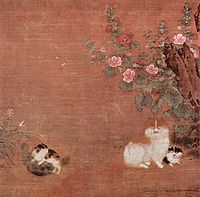Earliest history
The exact history of human interaction with cats is still somewhat vague. However, a shallow gravesite discovered in 1983 in Cyprus, dating to 7500 BC, during the Neolithic period, contains the skeleton of a human, buried ceremonially with stone tools, a lump of iron oxide, and a handful of seashells. In its own tiny grave 40 centimeters (18 inches) from the human grave was an eight-month-old cat, its body oriented in the same westward direction as the human skeleton. Cats are not native to Cyprus; they must have been brought over by boat. This is evidence that cats were being tamed just as humankind was establishing the first settlements in the part of the Middle East known as the Fertile Crescent.
Ancient Egypt
Cats, known in ancient Egypt as the miw, played a large role in ancient Egyptian society. Beginning as a wild, untamed species, cats were useful for keeping down vermin populations in the Egyptians' crops and harvests; through exposure to humans, the cat population became domesticated over time and learned to coexist with the human population.
Middle Ages
Since many equated the Black Death with God's wrath against sin, and that cats were often considered in league with the Devil thanks to their aloof and independent nature, cats were killed in masses. Had this bias toward cats not existed, local rodent populations could have been kept down, lessening the spread of plague-infected fleas from host to host.
Vikings used cats as rat catchers and companions.
A medieval King of Wales, Hywel Dda (the Good) passed legislation making it illegal to kill or harm a cat.
In Medieval Ypres cats were used in the winter months to control the vermin infesting the wool stored in the upper floors of the Cloth Hall(Lakenhall). At the start of the spring warm-up, after the wool had been sold, the cats were tossed out of the belfry tower to the town square below - which supppsedly symbolised "the killing of evil spirits". In today's Kattenstoet (Cat Parade) this was communted to the throwing toy cats from the belfry.
Renaissance
In the Renaissance, cats were often thought to be witches' familiars (for example, Greymalkin, the first witch's familiar in Macbeth's famous opening scene), and during festivities were sometimes burnt alive or thrown off tall buildings.
Europe

Folklore dating back to as early as 1607 tells that a cat will suffocate a newborn infant by putting its nose to the child's mouth, sucking the breath out of the infant. This, of course, is not true. If true, there would be an extremely large number of infants killed in this manner, due to the millions and millions of cats kept as pets in homes with infants.
Today some people still believe that black cats are unlucky or that it is unlucky if a black cat crosses one's path, while others believe that black cats are lucky. It is common lore that cats have nine lives. It is a tribute to their perceived durability, their occasional apparent lack of instinct for self-preservation, and their seeming ability to survive falls that would be fatal to other animals.
Japan
In Japan, there is the Maneki Neko, also referred to in English as the "good fortune" or "good luck" cat. It is usually a sitting cat with paw raised and bent. Legend in Japan has it that a cat waved a sword at a Japanese landlord, who was intrigued by this gesture and went towards it. A few seconds later a lightning bolt struck where the landlord had been previously standing. The landlord attributed his good fortune to the cat's fortuitous action. A symbol of good luck hence, it is most often seen in businesses to draw in money. In Japan, the flapping of the hand is a "come here" gesture, so the cat is beckoning customers.
Another Japanese Legend with cats is from Nekomata, when a cat has 13 years of life, it grows another tail and can stand up and speak in a human language.
0 comments:
Post a Comment